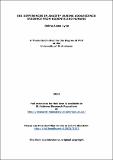Files in this item
Sex differences in anxiety during adolescence : evidence from rodents and humans
Item metadata
| dc.contributor.advisor | Brown, Gillian R. | |
| dc.contributor.author | Lynn, Debra Alana | |
| dc.coverage.spatial | 152 | en_US |
| dc.date.accessioned | 2012-09-24T08:35:16Z | |
| dc.date.available | 2012-09-24T08:35:16Z | |
| dc.date.issued | 2012-11-30 | |
| dc.identifier.uri | https://hdl.handle.net/10023/3152 | |
| dc.description | Electronic version does not contain associated previously published material | en |
| dc.description.abstract | Anxiety disorders commonly emerge during adolescence, and girls are diagnosed with these disorders more frequently than boys. Understanding why anxiety disorders emerge and why non-clinical anxiety symptoms increase during adolescence is important for understanding this sex difference and how to treat adolescent sufferers. Potential mechanisms, such as puberty or cognitive biases, can be investigated both in humans and in rodent models of anxiety. This thesis aimed to characterise sex differences and changes in anxiety-like behaviour across adolescence and into adulthood in the rat, and to examine anxiety and interpretive bias in adolescent humans. In rats, we examined performance on common tests of anxiety-like behaviour: the emergence test, open field and elevated plus-maze. Exploration on these tests increased from mid-adolescence into adulthood, and greater exploration by females was apparent from late adolescence. While the behaviours themselves remain interesting, caution on interpreting these behaviours as anxiety-related warranted and is discussed throughout the thesis. Potential effects of the ovarian cycle and testing order on EPM performance were also examined. In humans, 12-14 year old adolescents complete visual and written interpretive bias tasks, this bias being considered to be a cognitive vulnerability for anxiety. The results showed that, when imagining themselves in ambiguous scenarios, girls were more negative in their interpretations than boys. Additionally, both sexes also interpreted social scenarios more negatively than non-social scenarios. As puberty is thought to be important to the emergence of disorder during adolescence, interpretive bias could potentially mediate the puberty-anxiety relationship. While more interpretive bias work is needed in both species, the recent development of interpretive bias tasks for rodents provides an opportunity to move away from difficult to interpret tests of anxiety-like behaviour in rodents, and should allow for greater convergence of the human and rodent anxiety research. | en_US |
| dc.language.iso | en | en_US |
| dc.publisher | University of St Andrews | |
| dc.subject | Adolescence | en_US |
| dc.subject | Anxiety | en_US |
| dc.subject | Rodent | en_US |
| dc.subject | Interpretive bias | en_US |
| dc.subject | Anxiety disorders | en_US |
| dc.subject | Elevated plus-maze | en_US |
| dc.subject | Open field | en_US |
| dc.subject | Locomotor box | en_US |
| dc.subject.lcc | BF724.3A57L8 | |
| dc.subject.lcsh | Anxiety in adolescence--Sex differences | en_US |
| dc.subject.lcsh | Anxiety in adolescence--Psychological aspects | en_US |
| dc.subject.lcsh | Rats--Psychology | en_US |
| dc.subject.lcsh | Rats--Behavior | en_US |
| dc.subject.lcsh | Anxiety disorders | en_US |
| dc.title | Sex differences in anxiety during adolescence : evidence from rodents and humans | en_US |
| dc.type | Thesis | en_US |
| dc.type.qualificationlevel | Doctoral | en_US |
| dc.type.qualificationname | PhD Doctor of Philosophy | en_US |
| dc.publisher.institution | The University of St Andrews | en_US |
This item appears in the following Collection(s)
Items in the St Andrews Research Repository are protected by copyright, with all rights reserved, unless otherwise indicated.

